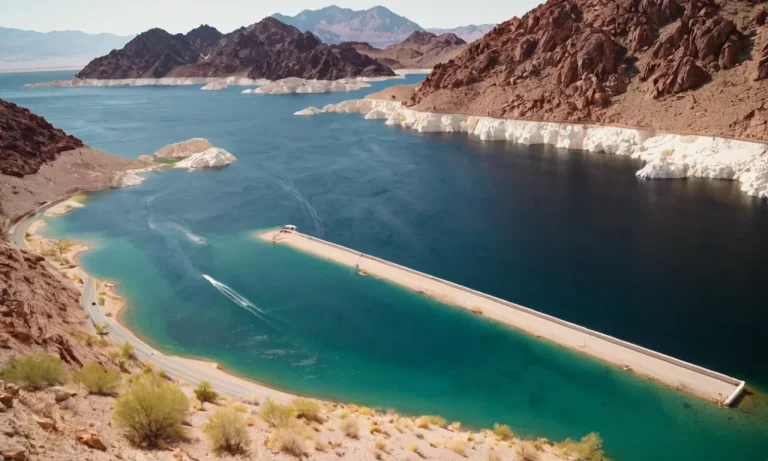States With All Four Distinct Seasons
The changing of the seasons is one of the most beautiful natural phenomena. The transition from winter to spring, spring to summer, summer to fall, and fall back again to winter marks the circle of life in many parts of the world. But not all states in the U.S. experience all four seasons distinctly.
If you’re short on time, here’s a quick answer: The Midwestern, Northeastern and certain Western states generally see equal times during all four seasons with moderate temperatures and clear shift between them.
In this article, we will take a close look at which U.S. states have four distinct seasons and what causes some states to have mild weather year-round or extreme shifts between seasons.
What Makes a Location Have Four Distinct Seasons
Many people enjoy living in areas where they can experience all four distinct seasons throughout the year. These locations offer a variety of weather conditions, each with its own unique charm. But what exactly makes a location have four distinct seasons?
Let’s explore the factors that contribute to this phenomenon.
Temperature Variation
One of the key factors that determines whether a location experiences four distinct seasons is the temperature variation throughout the year. In areas with four seasons, temperatures can range from hot and humid summers to cold and snowy winters.
The change in temperature is often drastic, creating a noticeable shift in the climate. For example, in the northeastern United States, temperatures can reach over 90 degrees Fahrenheit (32 degrees Celsius) in the summer and drop below freezing in the winter.
According to the National Oceanic and Atmospheric Administration (NOAA), the temperature variation in regions with four seasons is primarily influenced by the tilt of the Earth’s axis. As the Earth orbits the sun, different parts of the planet receive varying amounts of sunlight, resulting in seasonal temperature changes.
This tilt causes the changing of seasons, with summer occurring when a particular hemisphere is tilted towards the sun and winter when it is tilted away.
Precipitation Changes
Another factor that contributes to the presence of four distinct seasons is the variation in precipitation throughout the year. Different seasons often bring different types and amounts of precipitation. For example, spring may bring rain showers, while summer can bring thunderstorms.
In contrast, autumn may bring colorful foliage and cooler temperatures, and winter can bring snowfall.
The precipitation patterns in areas with four seasons are influenced by various factors, including atmospheric conditions, temperature changes, and geographical location. These factors interact to create the unique weather conditions associated with each season.
For example, in areas with a Mediterranean climate, such as California, the summer season is typically dry, while the winter season can bring rainstorms.
Daylight Hours
Daylight hours play a crucial role in determining the distinctness of seasons. In areas with four seasons, the length of daylight varies significantly throughout the year. This variation affects not only the temperature but also the overall feel of each season.
During the summer months, when the days are longer, people in these areas may enjoy more daylight for outdoor activities. As autumn approaches, the days gradually become shorter, leading to cooler temperatures and the vibrant colors of changing leaves.
In winter, the days are at their shortest, resulting in colder temperatures and less daylight. Finally, as spring arrives, the days gradually lengthen, bringing warmer temperatures and blooming flowers.
It’s important to note that the presence of four distinct seasons is not limited to specific regions or countries. Many locations around the world experience these seasonal changes, providing residents and visitors with a diverse and ever-changing climate to enjoy.
States with Four Distinct Seasons
When it comes to experiencing all four distinct seasons, there are several states in the United States that are known for their diverse weather patterns throughout the year. These states offer residents and visitors a chance to enjoy the beauty of spring blooms, the warmth of summer, the vibrant colors of fall, and the snowy landscapes of winter.
Here are three regions known for their four distinct seasons:
Midwestern States
The Midwest is often referred to as America’s heartland, and it is also home to some of the states with the most pronounced seasonal changes. States such as Michigan, Wisconsin, and Illinois experience hot summers, where temperatures can reach well above 90 degrees Fahrenheit, and cold winters, with heavy snowfall and freezing temperatures.
The region is also known for its beautiful fall foliage, with trees displaying stunning shades of red, orange, and yellow. Spring brings blooming flowers and a sense of renewal to the region.
Northeastern States
The Northeastern states, including New York, Vermont, and Maine, are famous for their picturesque landscapes and four distinct seasons. These states experience hot and humid summers, with temperatures often exceeding 90 degrees Fahrenheit, and cold, snowy winters, where temperatures can drop well below freezing.
The region is renowned for its stunning fall foliage, attracting visitors from all over the world. Spring in the Northeast brings a sense of rejuvenation, with blooming flowers and warmer temperatures.
Western States
The Western states, such as Colorado, Montana, and Wyoming, also offer residents and visitors the opportunity to experience all four seasons. Summers in these states are generally warm and dry, with temperatures ranging from the 70s to the 90s.
Winters can be harsh, with heavy snowfall in the mountainous regions. The fall season in the Western states is known for its breathtaking colors, as the leaves change to vibrant shades of red, orange, and gold.
Spring brings warmer temperatures and the blossoming of wildflowers, creating beautiful landscapes.
For those who appreciate the beauty and diversity of all four seasons, these states offer a unique opportunity to experience the wonders of nature throughout the year. Whether you prefer the warmth of summer or the tranquility of a snowy winter, there is a state with four distinct seasons to suit your preferences.
Other Factors Influencing Seasonal Changes
While the presence of all four distinct seasons is primarily influenced by a region’s latitude, there are several other factors that contribute to the variations in seasonal changes. These factors include proximity to large bodies of water, elevation and topography, and the presence of urban heat islands.
Proximity to Large Bodies of Water
Proximity to large bodies of water, such as oceans or large lakes, can significantly influence seasonal changes. Water has a high heat capacity, which means it takes longer to heat up and cool down compared to land.
As a result, areas near large bodies of water tend to have milder and more moderate seasons. For example, coastal areas often experience cooler summers and milder winters compared to inland regions at the same latitude.
This is because the water helps to regulate the temperature, acting as a natural air conditioner in the summer and preventing extreme cold in the winter.
According to a study conducted by the National Oceanic and Atmospheric Administration (NOAA), cities located near large bodies of water tend to have a smaller temperature range throughout the year. In fact, cities like San Francisco, Vancouver, and Seattle are known for their mild and temperate climates, thanks to their proximity to the Pacific Ocean.
Elevation and Topography
Elevation and topography also play a crucial role in seasonal changes. As you move higher in elevation, the temperature tends to decrease. This means that mountainous regions will experience cooler temperatures and shorter summers compared to low-lying areas.
Additionally, the presence of mountains or hills can create microclimates within a region. For example, valleys or basins surrounded by mountains may trap cold air, leading to colder winters and cooler summers compared to nearby areas.
A study conducted by the University of Colorado Boulder found that the temperature drops by an average of 3.5 degrees Fahrenheit for every 1,000 feet increase in elevation. This means that even within a single state, there can be significant variations in seasonal changes based on elevation.
Urban Heat Islands
Urban areas, often characterized by their high concentration of buildings, roads, and concrete, can create what is known as an urban heat island. The materials used in urban environments, such as asphalt and concrete, absorb and retain heat, leading to higher temperatures compared to surrounding rural areas.
This phenomenon can influence seasonal changes by causing warmer winters and hotter summers in urban areas.
According to a study conducted by the U.S. Environmental Protection Agency (EPA), urban heat islands can contribute to a temperature difference of up to 10 degrees Fahrenheit between urban and rural areas.
This means that cities like New York City, Los Angeles, and Chicago may experience more extreme seasonal changes compared to their surrounding suburban or rural areas.
Understanding these factors that influence seasonal changes can help us appreciate and better predict the variations we experience throughout the year. Whether it’s the cooling effect of nearby water, the temperature drop as we ascend a mountain, or the heat-trapping nature of urban environments, each factor contributes to the unique and diverse climates we encounter in different regions.
The Importance of Seasonal Change
Seasonal change is a natural phenomenon that occurs in various parts of the world. However, not all regions experience the distinct four seasons – spring, summer, autumn, and winter. States that have all four seasons play a crucial role in several aspects of life, including agriculture and food supply, tourism, and culture and traditions.
Agriculture and Food Supply
The availability of all four seasons is essential for agriculture and food supply in states. Each season brings specific weather conditions that are suitable for different crops. For example, spring provides the perfect environment for planting and growing a variety of fruits and vegetables.
Summer brings warm temperatures and longer days, allowing crops to flourish. Autumn is the time for harvesting, and winter offers a period of rest for the land.
States with all four seasons have a diverse range of agricultural products. They can grow a wide variety of crops, including grains, fruits, vegetables, and even specialty items like maple syrup or cranberries.
This diversity contributes to a robust local food supply and supports the economy of the state.
Tourism
The presence of all four seasons attracts tourists from all over the world. Each season offers unique experiences and activities for visitors to enjoy. In spring, tourists can witness the beauty of blooming flowers and enjoy outdoor activities such as hiking or picnicking.
Summer brings warm weather, perfect for beach vacations or exploring national parks. Autumn showcases breathtaking fall foliage, attracting nature enthusiasts and photographers. Winter offers opportunities for skiing, snowboarding, and other winter sports.
States with all four seasons have an advantage in attracting tourists throughout the year. The variety of seasonal activities creates a continuous flow of visitors, boosting the local economy and supporting businesses in the tourism industry.
Culture and Traditions
Seasonal change plays a significant role in shaping the culture and traditions of states with all four seasons. Festivals and celebrations are often centered around the different seasons. For example, the arrival of spring may be marked by a festival celebrating the blooming of cherry blossoms.
Harvest festivals in autumn celebrate the bounty of the land and the end of a successful farming season.
Seasonal traditions also influence the local cuisine, clothing, and even the way people interact with each other. In states with all four seasons, people adapt their lifestyles and customs according to the changes in weather and nature.
These traditions create a sense of identity and community, preserving the unique cultural heritage of the state.
Conclusion
The cycle of spring, summer, fall, and winter shapes the ecosystems and cultures of the areas where it occurs distinctly. States with four well-defined seasons tend to be found at middle latitudes instead of extreme northern or southern parts of the country.
Within the continental U.S., the Midwest and Northeast stand out as regions that exemplify the classic four seasons sequence that marks planting, growth, harvest, and dormancy in alignment with natural cycles.
As climate change continues to make an impact, the seasonal patterns in these regions and others may shift as well.








